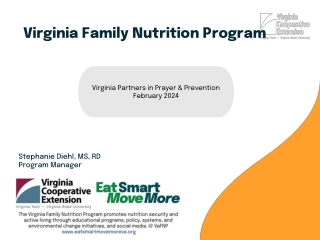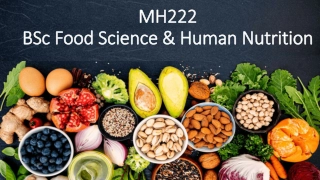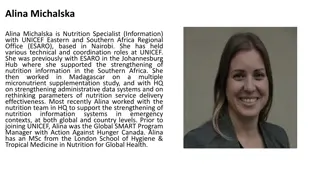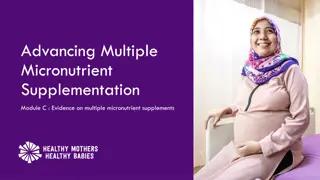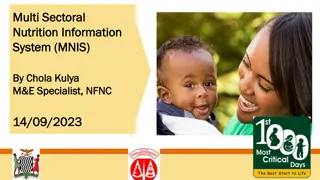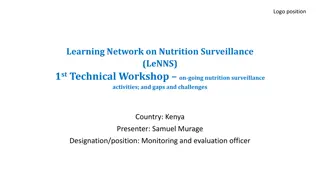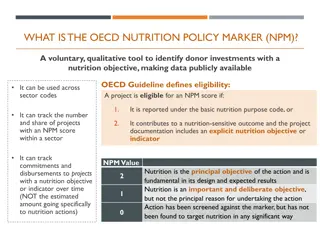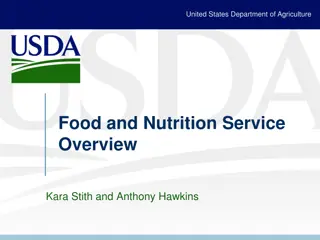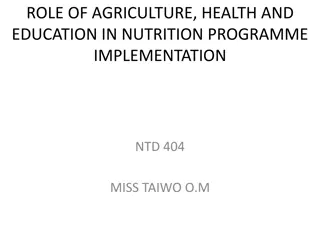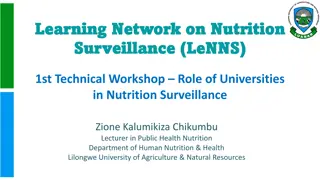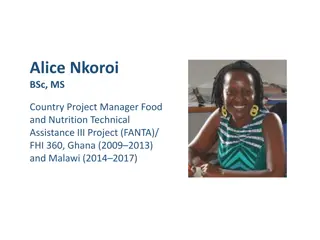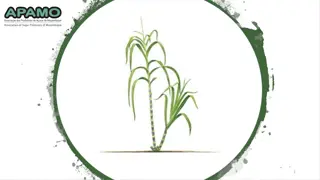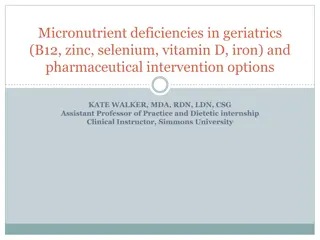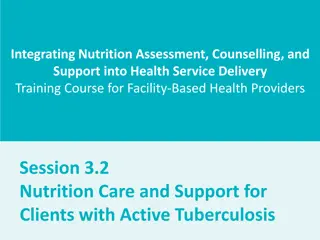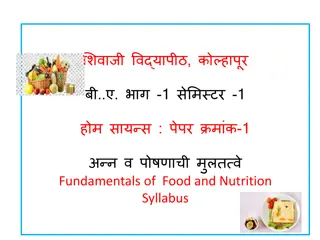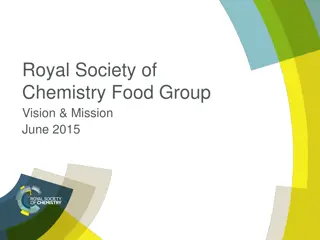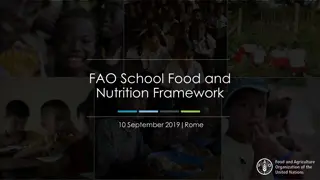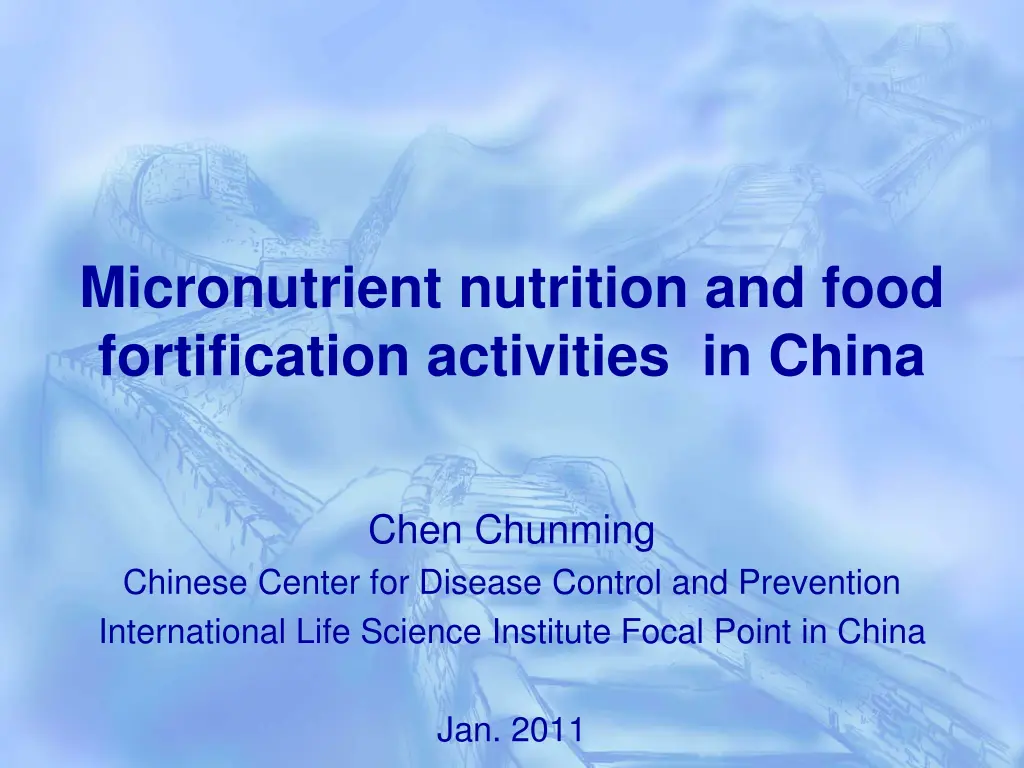
Micronutrient Nutrition and Food Fortification in China
Explore the current status of micronutrient nutrition and food fortification activities in China, focusing on addressing micronutrient deficiencies in the population. The article delves into topics such as iodine fortification, iron intake, dietary sources of iron, absorption rates, and anemia prevalence in different demographic groups.
Download Presentation

Please find below an Image/Link to download the presentation.
The content on the website is provided AS IS for your information and personal use only. It may not be sold, licensed, or shared on other websites without obtaining consent from the author. If you encounter any issues during the download, it is possible that the publisher has removed the file from their server.
You are allowed to download the files provided on this website for personal or commercial use, subject to the condition that they are used lawfully. All files are the property of their respective owners.
The content on the website is provided AS IS for your information and personal use only. It may not be sold, licensed, or shared on other websites without obtaining consent from the author.
E N D
Presentation Transcript
Micronutrient nutrition and food fortification activities in China Chen Chunming Chinese Center for Disease Control and Prevention International Life Science Institute Focal Point in China Jan. 2011
In the past ten years, the nutrition status of Chinese population has been dramatically improved in terms of energy and protein adequacy and general dietary pattern. But micronutrient deficiency is still a public health issue to be addressed, because of the plant food dominant diet.
I. Current micronutrient nutritional status in China
(1) Iodine Successfully controlled by mandatory salt iodization since 1993 The challenge will be program persistency Indicators 1995 39.9 1997 69.0 1999 80.6 2002 88.8 2005 90.2 Coverage of households consumed iodized salt (%) Median of urinary I2 In children aged 8 -10 ( g/L) 164.8 330.2 306.0 241.2 246.3 Goiter rate in children aged 8 -10 (%) 20.4 10.9 8.8 5.8 5.0% Source: National IDD Surveillance (MOH)
(2) Iron Dietary intake of iron In 2002 23mg/reference man
Dietary intake (mg/d) and source of iron in Chinese diet Big cities M/S cities Rural I 23.5 Rural II Rural III Rural IV 22.8 Total intake Food source of iron in diet (% of total intake) Cereals 32.2 41.2 Soybean 7 5.6 Vegetables 16.5 13.6 Potato 1.1 1.5 Meat & fish 13.3 12.2 24.5 23.5 22.6 24 43.6 6.1 15.8 1.8 10.7 54.4 5.9 15.2 2 6.9 61.6 4 11.5 2.4 2.9 53.3 7.3 12.6 3.2 8.7 Source: 2002 Nationwide Nutrition and Health Survey
Calculation of the intake of absorbed iron of Chinese Dietary intake of iron in 2002 23mg/reference man Assumed absorption rate of iron in Chinese diet ~4% Estimated Absorbed iron- 0.92mg 76% of requirement of adult man 54% of requirement of adult women 40% of requirement of 15-17yr adolescent girls (Actual intake: 20mg )
Anemia prevalence of population in 2002 Urban 13.4 21.5 Rural 16.7 24.0 Nat l 15.8 23.3 Male Female By age groups Children 6-11mon. 12-23mon. Women 18-44yr Adult >60yr Pregnant women Source: 2002 Nationwide Nutrition and Health Status Survey, Report 1 40.6 29.2 23.7 19.6 25.3 37.5 28.9 27.2 31.6 30.4 38.3 29.0 28.8 28.9
Minor/no reduction of anemia prevalence along with economic growth Malnutrition of children under 5 steadily reducing.but anemia almost no change during 1998-2005 Underweight % Stunting % Anemia % Year Urban Rural Urban Rural Urban Rural 1990* 8.0 22.6 9.4 41.4 13.1 17.6 1995* 4.6 17.8 8.9 39.1 - 1998* 2.7 12.6 4.1 22.6 15.2 17.7 2000* 3.4 13.8 2.9 20.3 12.3 26.7 2002** 3.1 9.4 4.9 17.3 12.7 20.8 2005* 1.8 8.6 2.5 13.1 11.6 20.3 % reduction during 1998-2005 78 62 73 68 11 -15 -
(3) Vitamin A Vitamin A deficiency Sub-clinical deficiency Prevalence of VA Def (% Serumretinol<20ug/dl in Children age 3-12) % 14.2 14.2 13.2 13.2 14 14 12.6 12.6 12 12 10 10 8 8 6 6 3.4 3.4 3.4 3.4 4 4 1.3 1.3 Children<2 supplementation proves deficiency 2 2 0 0 Big Big M/S M/S Rural 1 Rural 1 Rural 2 Rural 2 Rural 3 Rural 3 Rural 4 Rural 4 cities cities cities cities
Plasma retinol level of Chinese children (3-12y) ( mol/L) 1.4 1.4 1.3 1.3 umol/L) umol/L) 1.2 1.2 1.1 1.1 1 1 National National 0.9 0.9 Urban Urban 0.8 0.8 3 ~ 3 ~ 4 ~ 4 ~ 5 ~ 5 ~ 6 ~ 6 ~ 7 ~ 7 ~ 8 ~ 8 ~ 9 ~ 9 ~ 10 ~ 10 ~ 11 ~ 11 ~ 12~<13 12~<13 Rural Rural age age
Prevalence of plasma retinol level <1.05 mol/L in elderly population of China % 13.4 13.4 14.0 14.0 11.2 11.2 12.0 12.0 10.0 10.0 8.0 8.0 % % 6.0 6.0 3.8 3.8 4.0 4.0 2.0 2.0 0.0 0.0 Urban Urban Rural Rural National National VA(plasma) <30 g/dl Diagnostic criteria <30 g/dl
(5) Folic acid Serum and red blood cell folate concentration in Chinese childbearing age women by region Serum folate Red blood cell folate N Mean (nmol/L) Mean (nmol/L) Deficiency%(n)1 Deficiency% (n) South 901 16.3 0.78(7)* 533.9 7.8(70)* North 793 12.6 4.16(33) 305.4 54.9(435) Urban 864 15.1 1.5(13)* 463.8 21.2(183)* Rural 830 13.8 3.3(27) 362.4 38.8(322) Total 1694 14.5 2.36(40) 411.9 29.8(505) Source: Tang Yi (n) Number of deficiency * P 0.05 compared with the North 1 Deficiency defined as serum folate 6.8nmol/L(3 g/L) and red blood cell folate 318nmol/L(140 g/L)
Prevalence of plasma folate deficiency in Chinese adults by region Plasma folate (n mol/L) South Deficiency South North North n mean n mean n % n % Urban 618 17.39*# 613 8.76## 34 5.5* 205 33.4 # Rural 599 16.31* 626 7.86 36 6.0* 254 40.6 Total 1217 16.86* 1239 8.30 70 5.8* 459 37.1 Source: Tang Yi * P 0.001 Compared with the North #P 0.05, ##P 0.01 Compared with the rural area
(6) Vitamin B1 Thiamin Intake in Chinese Population ( mg /Reference man/Day) 1982 1982 3 3 2.6 2.6 1992 1992 2.5 2.5 2002 2002 2.5 2.5 2.1 2.1 2 2 1.5 1.5 1.2 1.2 1.2 1.2 1.1 1.1 1 1 1 1 1 1 1 1 0.5 0.5 0 0 National National Urban Urban Rural Rural RNI for adult man 1.4mg
(7) Vitamin B2 Riboflavin Intake in Chinese Population ( mg /Reference man/Day) 1982 1982 1992 1992 0.9 0.9 0.9 0.9 0.9 0.9 0.9 0.9 0.9 0.9 0.8 0.8 0.8 0.8 0.8 0.8 2002 2002 0.8 0.8 0.7 0.7 0.7 0.7 0.7 0.7 0.6 0.6 0.5 0.5 0.4 0.4 0.3 0.3 0.2 0.2 0.1 0.1 0 0 National National Urban Urban Rural Rural RNI for adult man 1.4mg
II. Micronutrient fortification as a public health strategy
(1) National program development Food fortification 1 Commonly consumed food fortification for general population accessible to rural, poor 2 In-home fortified food supplement for complementary feeding 3 Supplementation for pregnant and lactating mothers 4 Specific food fortification for disease prevention for areas with high prevalence Priority nutrients - Most common deficiency Iron, iodine With serious consequence Folic acid Vehicles salt, soy sauce, soy-based food, flour, rice,vegetable oil
(2) Framework of food fortification program Staple food/condiments for general population Fortification for complementary feeding Supplementation for pregnant women and young children (3) Fortified foods as tools for public health goal must be: Available in rural market production, marketing, to meet the consumer demand. Accessible to rural households distribution mechanism. expansion of distribution network. Acceptable to consumer Affordable by general rural families cost, packaging, price.
(4) Environment for sustainable food fortification program Integrated social marketing and public education-Ensure supply and enhance demand Policy and legislation encouragement -- Incentives and food quality and safety assurance Social responsibility of industry (manufacturer, retailers, super markets, village shops .). Public-private partnership
Policy making Advocacy/community mobilization Sectoral coordination Government Science for policy- making Information Legislation & standards Incentives for products Education Community mob. Funding Consumers Good Products Education Social marketing Professional societies Research, Information Industry assist Social marketing Product development reform/innovation Pricing strategy Distribution network Technical support Monitoring & evaluation Funding Collaboration Public-Private Partnership for food fortification
Activities combating micronutrient deficiencies in China
Progress of activities 1. soy sauce fortification
Iron fortified soy sauce: product development Annual output reached 93,000 MT 110 products produced by 22 producers marketed, Based on grades of soy sauce Grade 1 23 products; Grade 2 14 products Grade 3 66 products; Special grade 7 products. Based on types of packaging Bottle 56 products Soft bag 27 products Barrel 27 products Price ~ 10% higher than regular products
Production volume of fortified soy sauce MT*1000 100 90 80 70 60 50 40 30 20 10 0 2004 2005 2006 2007 Year 22 producers joined after training and improvement, Zhen Ji Group at Hebei province designated as a iron fortified soy sauce production base.
Consumer coverage 59.35 million Chinese residents use fortified soy sauce, including 39.87 million of at-risk population Baseline After 1 yr After 2 yrs IDA prevalence significantly decreased (women) 80% of at-risk population aware of the health benefits of iron fortified soy sauce
Anemia prevalence in the at-risk population reduced 30% or more in 7 provinces (sentinel data) Baseline After 1 yr After 2 yrs
2. Nutrient-dense food supplement (YYB) for complementary feedng
Reduction of anemia prevalence Reducing the rate of children anemia by using Fortified food supplement Reduce 47 for using 6 months 40 % Yingyangbao 34.2 35 34.9 Control 30 27.7 25 20 18.5 15 12.1 10 7.6 5 7.6 5 4.4 4.6 0 Baseline six months complementery twelve months complementery fifteen months complementery eighteen months complementery
Sustained Intelligence development of children supplemented with fortified food supplement FFS NFFS Control 104 104 98 98 102.9 97.2 96.7 95.5 102 102 101.4 96 96 101.1 94.5 100.8 93.6 93.7 100 100 94 94 92.7 98 98.3 98 98 92 92 96.6 90.4 96 96 95.2 90 90 88.3 94 94 88 88 93.3 92 92 86 86 90 90 84 84 82 82 88 88 VIQ VIQ PIQ PIQ FullIQ FullIQ 24 months 24 months 3-4 years Supplement food added to CF during 6-24 month of age. IQ Test done after completion of supplementation at age 3-4,4-5,5-6 years old 3-4 years 4-5 years 4-5 years
Ongoing activities on the application of nutrient-dense supplement food (YYB) in China(1) Activity Earthquake areas Li xian Settings Institution China CDC,Unicef, Gain Company: Bailemai Effectiveness Since 2008 Sept. Anemia % from 71.8% reduced to 31.9% in 1.5 years Since 2010 June Children 6-24 months Prevention Program 8 earthquake counties in 3 province Children 6-24 months 12 provinces 23,000 children 6-24 mionths MOH, Unicef, China CDC Companies: Bailemai, Extension Program MOST, China CDC Since 2010 April Established distribution mechanism Companies:
Ongoing activities on the application of nutrient-dense supplement food (YYB) in China(2) Activities Settings Institutions Effectiveness Social Equity Project- policy research 2 counties in 2 provinces Qinghai & Yunnan Province a. 6-24 months children YYB daily b. multi nutrients supplements for pregnant women CDRF, China CDC , ILSI-FP China Since 2009 Sept.in 12 months: a. Anemia reduction from 66% to 38.7% b. Stunting % of children aged <18 month reduced c. Diarrhea and fever incidence reduced d. % of LBW halved Company: 1. DSM for YYB. 2. Shiji Weita for supplements for pregnant women
Flour fortification 1993-2000 Science and feasibility study of flour fortification 2000-2002 Technology study of flour fortification in Chin 2003-2008 Wheat fortification in Reforest compensation program: Dingxi project Wheat flor fortification in high NTD prevalence counties in Shanxi Current discussion on regional wheat flour fortification RETA Project The colored part in the figure are the major wheat consumption provinces in Mainland China, among them, Henan, Hebei and Shandong are the provinces with biggest production and consumption.
1. NTD incidence in relation to the consumption of fortified wheat of women in a county (with 9132 child-bearing age women involved) in Shanxi( n=846) Live birth NTD % Incidence Normal NTD <1000g/m <33g/day) FA*<22ug/day 1000g/m~ (33-116g/day) FA 23-78ug/day 3500g/m~ (117-233g/day) FA 79-157ug/day >7000g/m (>234g/day) FA >158ug /day Total 6.8 53 5 86.2 31.8 266 3 11.2 16.8 141 1 7.04 44.6 376 1 2.65 100.0 836 10 11.8 * FA=folic acid, calculated by folic acid fortified in the wheat flour
2. Nutrient enrichment in wheat flour in Hebei and Gansu Province 1.8 1.8 20 20 1.6 1.6 Zn intake (mg/d.p) Zn intake (mg/d.p) 18 18 1.4 1.4 16 16 VB1 & VB itake2 VB1 & VB itake2 1.2 1.2 14 14 1 1 (mg/d.p) (mg/d.p) 12 12 VB1(L) VB1(L) VB1(W) VB1(W) VB1 DRI VB1 DRI VB2(L) VB2(L) VB2(W) VB2(W) VB2 DRI VB2 DRI 0.8 0.8 10 10 0.6 0.6 8 8 Zn(L) Zn(L) Zn(W) Zn(W) Zn DRI Zn DRI 6 6 0.4 0.4 4 4 0.2 0.2 2 2 0 0 0 0 month month 0 0 6 6 12 12 18 18 24 24 30 30 36 36 month month 0 0 6 6 12 12 18 18 24 24 30 30 36 36 900 900 VA intake (mg/d.p) VA intake (mg/d.p) 800 800 20 20 700 700 600 600 Niacin intake Niacin intake 15 15 500 500 VA(L) VA(L) (mg/d.p) (mg/d.p) 400 400 VA(W) VA(W) 10 10 300 300 nacin(W) nacin(W) VA DRI VA DRI 200 200 100 100 5 5 nacin(L) nacin(L) 0 0 month month 0 0 6 6 12 12 18 18 24 24 30 30 36 36 0 0 month month 0 0 6 6 12 12 18 18 24 24 30 30 36 36
Applied in 2211 rural households in 2 villages for 3 years (2003-2006) Status of micronutrient deficiencies improved: Iron deficiency reduced in terms of biological assessment Serum folic acid and zinc level improved Marginal vit. A deficiency reduced from 31.9% to 3.7% in Weichang and from 12.1% to 2.2% in Lanzhou.
4. Application of comprehensive food fortification in school
FFO of China CDC applied comprehensive food fortification interventions in PuGongYing Middle school in 2007 Using fortified soy sauce and VA fortified vegetable oil for cooking, and consuming fortified rice among 500 students for 8 months: 1.Anemia Prevalence reduced to the average of the same area (see fig); 2. Marginal VA def. reduced from 15.4% to 6.4% . 13.7 14.0 12.0 10.0 8.0 6.0 3.9 4.0 2.5 2.0 0.0 Baselne Baselne Intervention Intervention in the area in the area
Cost for comprehensive intervention Cost increased Yuan/day) Boys 0.0015 Girls 0.0015 Fortified so sauce VA fortified veg. oil 0.015 0.015 Multi-nutrients fort. rice 0.06 0.03 Eggs 0.21 0.21 Total cost 0.29 0.26
Appeal for partnership Government Policy, regulation & standards, advocacy, sectoral coordination Scientists Research, product evaluation, information, public education, assist social marketing Industry -- R&D, production,distribution, price, safety, social responsibility, social marketing No partnership among them, no success of national program.
Looking into the future The activities are supported by the governmental sectors such as MOH, National Grain Bureau, and local governments; But still are at project basis and societal experiment level; We are on the way of scaling up Policy making, industry commitments to social responsibility on massive fortification, intensive and effective public education on the health and development benefits of fortified food are the requisites for scaling up.; We fell confident , but there is a long way to go!

